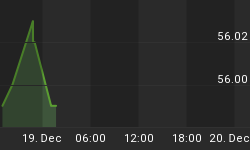The following is part of Pivotal Events that was published for our subscribers Thursday, October 21, 2010.
Three Years Ago:
"We are very good at takeovers and the transition."
- Ken Lewis, CEO at Bank of America, September 15, 2007
On the takeover of Merrill Lynch
"There is no way to stabilize the markets other than through government intervention."
- Treasury Secretary Hank Paulson, WSJ, September 24, 2007
The notion that the Fed will provide liquidity when needed and then to cool subsequent speculation has been around since its advent. That it has been an impossible, if not impractical, task is shown in the 96 percent depreciation of the purchasing power of the dollar. If the central bank had the skills to match its boasts there would have been no depreciation.
This has been an essential part of building a rare Century of Hyperinflation in the senior currency. The two previous examples ran through the Third Century and Sixteenth Century. The greater the intervention - the greater the volatility.
This Year:
"Stock Market Keeps on Rolling No Matter How Bad The News"
- CNBC, October 8, 2010
"Soaring prices threaten new food crisis"
- Financial Times, October 10, 2010
"Hedge fund managers turn bullish on stock market"
- Reuters, October 12, 2010
"Foreign investors scoop up US debt"
- Financial Times, October 18, 2010
This was for the month of August when a near record amount was bought, with a "sharp increase" in Treasuries.
Stock Markets
Last week the Fed again became so desperate as to promise more inflation and as the Financial Post headlined it: "Learn to love inflation". Conventional thinking is that commodity price inflation will feed into wholesale price inflation and that, in turn, will lead to consumer price inflation.
Then the debt can be serviced. The problem remains that in every financial mania the world takes on more debt than even a "normal" economy can service. Actually, the debt load taken on in great enthusiasm eventually becomes understood as a burden that has to be liquidated before the economy can really grow.
The Fed continues in its effort to make a credit contraction go away by throwing more credit at the problem - which is too much debt to begin with.
As this theoretical world continues on the path to the biggest reality show in history markets have become rather volatile. And as we have been noting, the "All-One-Market" (AOM) is based upon the ability of the Fed to slam the dollar.
Fortunately, the extremity of this move is becoming more and more obvious. As reviewed above, since early September the media are reporting exclamations about the credit markets, commodities and stocks similar to those of September and October of 2007.
Anecdotal exuberance is being confirmed by clinical sentiment measures.
At the timely April high there was the Daily Sentiment figure was at 92% Bulls. Now it is at 93%. These are extremes and compare with the 2% number as the crash ended in early March 2009. Needless to say, but that dismal reading was accompanied by a number of panicdotal quotations.
Other numbers that have become critical are riding the currency action. The DX has reached a rare low of 3% Bulls on the Daily Sentiment. This compares to the 7% at the late 2009 low and the 7% at the July low. Of interest and as noted last week these "lows" for the DX have increased from 70 in 2008 to 74 with the 2009 low and to 80 with the April low. The recent low has been 76 within a very powerful drive to trash the dollar.
The dollar has been registering a Downside Capitulation which suggests last week's 76 level could be an important low.
Forces acting upon stock markets continue to be outside the usual analysis about earnings, GDP and the Fed. Moreover, the Fed should no longer be considered as "managing" the economy. Actually the Fed has turned into the speculator of last resort and the consequences of such radical behaviour have yet to be fully understood.
In the meantime, this week's action has been choppy as a potential turn starts to resist the compulsion to buy - or with the dollar - sell.
As we have been noting the gold/silver ratio has been pounded down to a very oversold condition and any turn up will signal the decline in the All-One-Market phenomenon.
The last few days seem to be accomplishing the best effort since the high of 68 in August. Thursday and Monday set a quick double bottom at 56 on closing prices. The high on Friday was 57, with yesterday's close at 56.3.
Today's range has been 55.9 to 57.4. With the close at 57.3 has accomplished an outside reversal and a set of rising highs since early Tuesday.
This is a big alert on "AOM" heading down. Rising through 60 will warn of the next liquidity concern.
Interest Rates
Friday's ChartWorks updated the August 25th edition that said "Bye Bye Bonds". The high was 136.84 on the previous day and the initial decline was to a little under 130, which is support.Friday's review also noted that overhead resistance at the 133 level was critical. If it does not rise through as the stock market stalls out the usual relation would become suspect.
On the other hand, most commodities have been hot and should they cool it will be interesting.
Speculation in long treasuries continues impressive.
As does the action in the corporate sector.
There seems to be little in technical patterns that would prompt any decisions.
Link to October 22, 2010 'Bob and Phil Show' on Howestreet.com: http://www.howestreet.com/index.php?pl=/goldradio/index.php/mediaplayer/1813
















